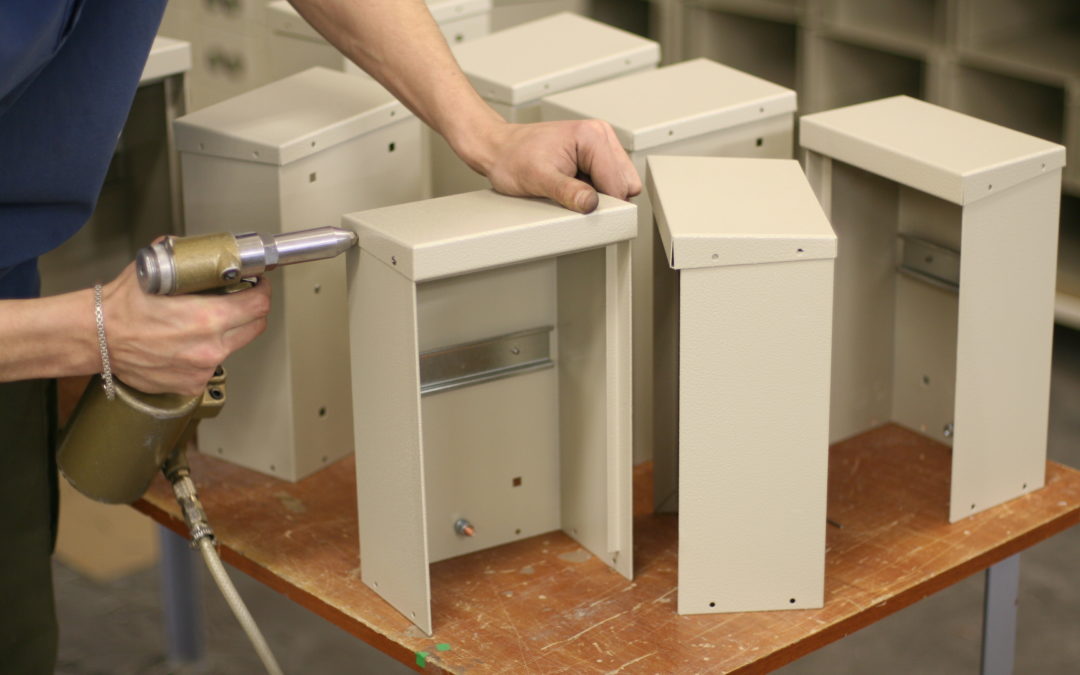Creating a finished product requires more than just metal fabrication – you also need to determine your finishes, choose packaging and figure out how to take all your sheet metal and other components and put them together.
As far as putting your components together, there are a few options to choose between.
The Different Assembly Types
The type of assembly method used will depend on the materials being assembled, how durable the final product needs to be, and whether or not the assembly is permanent. By consulting with a professional on your project, you can verify the right method for your work. These methods include:
Mechanical Assembly
Mechanical assembly utilizes different types of hardware to assemble parts together. This can include nuts, bolts, screws, and similar materials. Mechanical assembly is ideal for pieces that may need replacement parts in the future, require adjustments or any sort of work that is not permanent.
Weld Assembly
Weld assembly is the process of fusing pieces of metal together to become one piece. This is ideal for structural components that will be permanent. Because the pieces are fused together, this is the strongest assembly option.
Spot Weld Assembly
Spot weld assembly bonds sheet metal together in a less permanent, less expensive way than weld assembly. This method is perfect for things like cabinets, where a more permanent solution than mechanical assembly is required, but the pieces can’t support the permanence of weld assembly.
Rivet Assembly
Rivet assembly is a permanent assembly type that utilizes rivets – which are bolt-like fasteners – to assemble two pieces together. Once the rivet is secured for assembly, the base expands up to one-and-a-half times its size. This secures the rivet and assembles the pieces together.
Because no welding occurs, this is an ideal method for assemblies that include different types of materials.
Your Assembly Options
No matter the type of assembly required, there are multiple choices for outsourcing your assembly needs. Whether you need a full assembly, a few pieces put together, or just components right off the manufacturing line, there’s an option for you.
Sub-Assembly
Sub-assembly is the most basic form of assembly – it involves taking your first piece, or base, and attaching different components to it. This process leaves you with “component assemblies” that can then be included in larger items throughout the process.
While a sub-assembly is often done in an initial location and then shipped to a secondary facility to be added to the final product, at Highland Machine we are able to take these pieces and continue the process in-house. This helps cut down on production time and costs while ensuring a high-quality product.
Partial Assembly
Partial assembly is essentially what it sounds like – a product that is partially assembled and delivered with the intent of the final assembly being completed at a different location. This is ideal for companies that outsource a portion of their manufacturing while keeping a portion in-house.
For an example of this option, we can look to Bitrode, a battery testing and equipment company that utilizes partial assembly from Highland Machine to outsource a portion of their electrical cabinet assembly. By providing a solution where cabinets were sent to Bitrode partially assembled and ready for finishing in-house, Highland Machine was able to increase their order capacity.
Full Assembly
Full assembly is when a product is delivered assembled and ready to go. This assembly allows a product to go directly to market from the supplier or be 99% of the way there.
For example, CK Power utilizes Highland Machine’s full assembly services for mobile power generators. Highland Machine not only handles the sheet metal fabrication and powder-coating, but also the full assembly of the product for CK Power. Then, when CK Power receives the generators, they add the engine and the product is complete.
Full assembly typically saves time and costs by allowing for all pieces to be completed in one location, lowering downtime between processes, reducing labor costs, and avoiding the expense of shipping products between vendors. It also reduces the risk of pieces being damaged during transportation from the metal fabricator to the assembly location.
All Your Production Needs Under One Roof
While there are many options for assembly types and options, one thing remains true: having all of your services complete under one roof saves time and money. By reducing downtime between processes, lowering labor costs, and limiting the risk of product damage during transportation, it’s important to find a team that can handle everything in one place. Plus, you can increase your savings by utilizing our in-house powder coating and inventory management services.
If you’re looking for a solution to sheet metal fabrication, assembly, and more, contact Highland Machine today!
